The first Star Trek pilot, The Cage, was produced in 1964. To celebrate its fiftieth anniversary, this December we are reviewing the second season of the original Star Trek show. You can check out our first season reviews here. Check back daily for the latest review.
Journey to Babel is pretty influential, as episodes of Star Trek go. It is an episode that really cements idea of the Federation that came to be at the heart of the franchise, suggesting that the organisation really is a diverse intergalactic alliance of diverse alien species, rather than a union between Earth and Vulcan. More than that, the episode suggests that the individual members of the Federation might not exist in perfect harmony with one another, but may each operate with their own agenda and motivations.
However, what is really remarkable about Journey to Babel is how much of this unfolds in the background. All this world-building and -embellishing is very much a secondary concern for writer D.C. Fontana. Despite its scale and its scope, Journey to Babel is a decidedly personal story about a family in crisis. It works remarkably well, offering viewers a bit more insight into Spock as a character and where he came from.
In an interview with Emmy TV Legends, D.C. Fontana explains that the idea for Journey to Babel came from a variety of sources, building off lots of little bits and pieces seeded throughout earlier episodes:
That’s my favourite. That was in the second season, I was kicking around stories and I finally went into Gene – I always went into Gene because that was the man you told the stories to first. I said, “I want to do something about Spock’s mother and father.” Because we had hinted in The Naked Time a little bit about his mother, and a little bit in This Side of Paradise about his mother and his father, and I said, “Let’s explore that relationship.” And it was really about the generation gap – we don’t call it that any more, but it still exists, the distance between parents and children – and how it can be a wall or something warm and lovely. And, in this case, it was a wall between father and son. And then I wrapped it up in a mystery and an adventure.
It is an interesting approach to continuity, one that suggests strands suggested earlier on can be fashioned together to make a more compelling whole. It suggests that continuity is not something that arrives fully formed, but one that it built up over time.
While sixties television did not feature the same sorts of narrative continuity that modern viewers take for granted, it was still there. Although episodes of prime time television show were generally episodic in nature, little bits of character history could be build up over time, allowing the show to sketch a portrait of those characters over an extended run. This is an approach that tends to involve building more continuity on top of existing continuity, as if building from the ground up. Star Trek favoured this approach.
Very little of that continuity was pre-planned or baked into the show. It is interesting to read the writers’ bible for Star Trek, to get a sense of how the day-to-day continuity was something quite apart from the back story baked into the scripts. There are a few differences between the details in the guide and what would be established – for example, prospective writers are informed that the Enterprise is “official designation ‘starship class'”, although the show would designate it Constitution Class.
There are also details that were subsequently fleshed-out and developed on the show – while there is a reference to Spock’s “half-breed” status and his Vulcan father and human mother in the bible, the relationship is left vague. In contrast, there are also aspects of continuity that never made it to screen on the show itself – McCoy’s divorce and his daughter Joanna were never mentioned in the live-action show, despite featuring heavily in the bible.
Continuity on Star Trek tends to develop this way, with various writers building on what came before and pushing something that had been established a little bit further or a little more forcefully. The characters of Sarek and Amanda were not fully-formed when The Man Trap aired. Instead, Fontana fashioned them from references made in later episodes, crafting characters to fill a hole with a rough outline established by snippets of dialogue from the first season.
Discussing the episode at Vaka Rangi, Josh Marsfelder argues that there are two approaches for character (and continuity) development, and that Journey to Babel demonstrates which way D.C. Fontana approaches such development:
The first takes a character who has a specific worldview and personality borne out of a specific positionality and is predominantly interested in seeing how they respond to a given situation, be it widespread event, an interaction with another character or so on and so forth. The second is more interested in constructing a meticulous fictional biography of the character based on, among other things, throwaway lines in other episodes, and using that to construct a comprehensive profile and life history of this character as a person. To put it another way, the first approach can be summarised as “What is this character like and how do they react to the story of the week?” while the latter can be summarised as “Why does this character think the things they think and act the way they do?”. Journey to Babel is very much in the latter style, and I have a feeling this is the style D.C. Fontana prefers on the whole, at least at this stage in her career. It’s also the style that is most clearly identifiable with Star Trek.
This approach toward characterisation also applies to the development of the wider Star Trek universe itself. Reverse engineering rather than planned design. Klingon culture developed largely as needed. On Star Trek: Deep Space Nine, the Breen were an entire species cobbled together from off-hand references in Star Trek: The Next Generation.
It is an approach that tends to harness negative space created by earlier scripts to create character and continuity. It relies on earlier episodes to provide outlines and shadows that the writer may later fill in. It is not an approach that suggests the existence fully-formed universe before production begins. It suggests a continuity that is still forming and crystalising, rather than one that has been fully thought-through before the show entered production.
In modern television, it is not uncommon for showrunners to boast about extended plans for their shows. Bryan Fuller, for example, has mapped out six or seven seasons of Hannibal. David S. Goyer claimed to have a five-year plan for Flashfoward, which was cancelled after its first season. Even in feature films, Marvel Studios maps out their production slate five years in advance. There is an increasing tendency to work from a continuity blueprint, rather than to develop organically.
As a rule, Star Trek doesn’t do this. It tends to make things up as it goes along. This arguably contributes to some of the franchise’s awkward continuity hiccups. After all, Starfleet could not be mentioned early in the first season of Star Trek, because it didn’t exist until Court Martial. The level of biological similarity between Vulcans and Romulans depended on plot necessity. Sisko’s father seemed to be dead in the early seasons of Deep Space Nine, until it turned out that he wasn’t.
However, this lack of a clearly structured and defined continuity could be a boon sometimes. J. Michael Straczynski’s well-planned and -plotted Babylon5 was frequently knocked off course by inconvenient off-screen developments, while Deep Space Nine was more flexible and prone to experiment. Much like Journey to Babel was fashioned from stitching together various preexisting references into a cohesive picture, Deep Space Nine was able to deliver a massive twist on the character of Julian Bashir based solely on a throwaway line in Homefront.
As a whole, Journey to Babel is perhaps the best example of this “snowball” approach to continuity and development. It’s an episode that takes a lot of what has been suggested and implied by earlier episodes, only to crystalise it. We finally get to see members of the Federation beyond humans and Vulcans. We finally get to meet Spock’s parents. These are two core parts of the mythos, and – although suggested in earlier scripts – they are finally presented here.
Sarek and Amanda would go on to become a key part of the Star Trek mythos. Portrayed by Jane Wyatt, Amanda would reappear in Star Trek IV: The Voyage Home, helping Spock to get in touch with his human side. However, the character would pass away during the long gap between the original Star Trek and the launch of The Next Generation. Sarek would become something a fixture in the Star Trek franchise, appearing in half of the films featuring the original cast and appearing twice on The Next Generation.
Mark Lenard was cast as Spock’s father. Lenard made quite an impression as the anonymous Romulan commander in Balance of Terror, but he would become primarily associated with the role of Sarek. Lenard gives Sarek a quiet dignity, very cleverly crafting his performance to mirror the more detached aspects of Spock’s personality. Sarek’s posture and mannerisms are very much like those of Spock, but Lenard deals back even the faintest trace of emotion.
Sarek is a fascinating character. Journey to Babel explicitly confirms that the Vulcan ambassador disapproved of his son’s decision to join Starfleet. It was clear that Sarek had a future mapped out for his son and heir. Discussing Spock with Kirk, Sarek matter-of-factly observes, “He chose to devote his knowledge to Starfleet instead of the Vulcan Science Academy.” This makes it clear that Sarek had very clearly delineated plans for Spock, much like parents who intend their children to attend particularly schools or enter particular professions.
As Fontana concedes, the relationship between Spock and Sarek touches on the generation gap that was very much a part of sixties culture. In this respect, Fontana had her finger on the pulse. Produced in late 1967 and aired in early 1968, it captured the mood of the moment, as outlined by Alan Sica in the introduction to The Disobedient Generation:
But between April and the fall of 1968, the focus shifted to “The Generation Gap”, not least because many of the general magazine subscribers were upper middle-class professional men and their homemaker wives, whose very children had become the avant-garde of “The Movement.” Life magazine went so far as to run a cover story called “The Generation Gap”, which featured a heartfelt, almost unbelievably earnest dialogue between a forty-two-year-old uncle (Ernest Fladell) and his twenty-year-old nephew (Richard Lorber), by whose kindness the latter was able to attend Columbia University while living in the elder’s home in Manhattan.
Teenagers and young adults were growing up in lives of material comfort and peace, children of parents who had fought in the Second World War and endured the Great Depression to makes such things possible. A divide was inevitable as parents found themselves coping with choices made by their children that were never available when they were younger.
That said, although the “generation gap” is a core part of sixties culture, is not a phenomenon unique to the sixties. As Caroline Hoefferle notes in British Student Activism in the Long Sixties, there was a turbulent generation gap only a decade or so earlier:
More recently, however, historians of the post-war period have found that so-called permissive trends and worries about youth rebellion date back to the 1940s, a generation before the baby-boomers. Historian Nick Thomas points to a number of studies which have demonstrated the existence of rising rates of juvenile delinquency in the 1940s, and a rising tide of public hysteria in reaction to it dating to the 1950s. Social commentators and the news media in the fifties worried about youth rebellion and blamed the lax discipline associated with the banning of flogging and birching in 1948.
The generation gap remains a pressing issue. Recent studies suggest that the current gap is as wide as it has been since the sixties.
This divide between Sarek and Spock is another example of what made Spock such a fascinating counter-cultural figure. While Kirk was the lead of the show, it was Spock who seemed to strike a chord with the younger viewers. Episodes like The Naked Time, This Side of Paradise and Amok Time portrayed Spock as a character struggling with social mores and his own repression – trying to find a balance between what he needed and what society expected from him. It is telling that Spock is the character most sympathetic to the space hippies in The Way to Eden.
Spock’s disagreement with his father resonated with younger viewers dealing the expectations of their parents. Just as Starfleet offered Spock a chance to see “new worlds and new civilisations”, the young people of the sixties were presented with more opportunities than their parents had known. While it may have been safer to follow the path laid out for them by concerned parents, many decided to find their own way in the world. In the summer of 1967, many of these young people had taken to San Fransisco to express themselves and enjoy those freedoms and potential.
D.C. Fontana is probably the best character writer to work on the original Star Trek. More than any other member of the creative team, Fontana understood the characters inhabiting the Enterprise. In fifty minutes, Fontana is able to present viewers with a fully-realised portrait of a dysfunctional Vulcan family, suggesting the cracks in the facade, the shared history and the unspoken understandings.
For all that Spock takes pride in his work and his willingness to forge his own identity, it is clear that he still yearns for his father’s approval. After all, Spock desperately seeks to assert his Vulcan identity. While he offers all manner of justifications for his refusal to assist his father, Spock seems concerned about what Sarek might think of such sentimentality. “Can you imagine what my father would say if I were to agree?” he asks his mother. “If I were to give up command of this vessel, jeopardise hundreds of lives, risk interplanetary war, all for the life of one person?”
For his part, Sarek might hide his emotions better than Spock, but he is still a proud man. Early on, he excuses himself from a diplomatic function. “Excuse me, Doctor,” he states. “It has been a rather long day for my wife. Captain.” Never mind that Amanda seems to be enjoying the conversation. It seems more likely that Sarek was trying to save face and manage his own debilitating physical condition. Even when accused of murder, Sarek tries to conceal the illness from his son and from Kirk, a lie enabled by Amanda – acutely aware of her husband’s weakness.
Sarek is also – like most Vulcans on Star Trek who are not Spock – quite remarkably rude. When the Tellarites hassle him about his preference on the matter of Coridan, he refuses to be drawn. While the Tellarites claim to have legitimate concerns – and certainly have a legitimate reason for wanting to know Sarek’s position – Sarek is incredibly dismissive. “Tellarites do not argue for reasons,” he states in a crowded room packed with assembled dignitaries. “They simply argue.”
It does seem a little strange that Sarek’s dismissal of the Tellarite position becomes the entire basis for their culture when the Tellarites reappear on Star Trek: Enterprise. It is an example of that creeping continuity mentioned earlier, but it is also a demonstration of one of the impulses in fandom. Like the fan outrage over the rude Vulcans on Enterprise, this is a demonstration of how certain fan beliefs can end up enshrining themselves in continuity, leading to some strange storytelling decisions to preserve fandom’s perspective.
The Vulcans on Star Trek were hardly polite and friendly. The franchise has never presented any Vulcan except for Spock as particularly “nice.” In Amok Time, Spock’s betrothed conspired to dissolve their union in a plot that would have killed either Kirk or Spock. Nobody on the planet bothered to point out to Kirk that he would be fighting to the death. Once that piece of information was revealed, T’Pau would not let him opt out. Even Tuvok’s defining moments in the first season of Star Trek: Voyager emphasise how disconnected he is from his colleagues.
Here, it is suggested Vulcans politely disapprove of Starfleet. Discussing Spock’s decision to enter the Academy, Amanda offers, “My husband has nothing against Starfleet. But Vulcans believe that peace should not depend on force.” Although phrased much more delicately than the Vulcan position in Enterprise, it is not inconsistent with it. However, prompted by fandom’s shared memory of Vulcans and ignoring fairly consistent characterisation from as early as Amok Time, Enterprise felt the need to account for the perceived mischaracterisation.
It is perhaps a testament to the franchise’s rose-tinted glasses that Sarek’s incredibly impolitic public remark would become the defining racial characteristic of Tellarites when they reappeared decades later. Even bearing that in mind, Sarek’s declaration still seems rather rude. In the context of the episode, it is presented as one of the indicators that something is not quite right – red herrings that provide circumstantial evidence that Sarek may be a killer, but also a suggestions that Sarek may be under some strain.
As with Spock, Fontana cleverly suggests that Sarek is not emotionless – he is just well-versed in concealing his emotions. Although he would never say it to Spock’s face, it is clear that he is proud of his son. When Amanda tells the story about Spock’s pet “teddy bear”, Sarek quietly rebukes her. “You embarrassed Spock this evening. Not even a mother may do that. He is a Vulcan.” He adds, “He is in Starfleet. He must command respect if he is to function.” Amanda replies, “Sarek, you’re proud of him, aren’t you? You’re showing almost human pride in your son.”
Journey to Babel is so well constructed that even the medical drama plays out as a metaphorical extension of the plot. Of course Sarek’s heart is the problem – while it may not be working as expected, the medical crisis proves that it is there. The key is to fix Sarek’s heart. Discussing treatment options, McCoy muses, “On a Vulcan, an ordinary operation’s out of the question.” Sarek clarifies, “Because of the construction of the Vulcan heart.” The Vulcan heart is a most unique and distinct organ, very different from the human equivalent.
Even Spock’s involvement with the treatment plays into the metaphor. “We’ve run a number of blood tests on Mister Spock,” Nurse Chapel observes. “It isn’t true Vulcan blood either. It has human blood elements in it.” As ever, Spock’s human half prevents him from being the Vulcan that his father wants (and needs) him to be. Naturally, it is Spock who proposes a solution. “It should be possible to filter out the human factors.” You could argue that Spock has been doing that all his life.
D.C. Fontana’s influence on Spock’s development is so strong that her work can be identified as a core part of JJ Abrams’ rebooted Star Trek. While the films contain countless nods to the work of other writers, there is a clear thematic throughline from D.C. Fontana’s characterisation of Spock, to the point where the film actually features the story that Amanda relates here about her son’s tortured childhood as a major character moment for Spock.
In an absolutely beautiful moment between Jane Wyatt and Leonard Nimoy, Amanda recalls, “When you were five years old and came home stiff-lipped, anguished, because the other boys tormented you saying that you weren’t really Vulcan, I watched you, knowing that inside that the human part of you was crying and I cried, too.” Beyond the fact that it reinforces the recurring “Vulcans are not nice people” motif that runs through Star Trek, the reboot actually made a point to introduce us to the Vulcan bullies.
That’s a testament to Fontana’s writing. While Roberto Orci and Alex Kurtzman had to effective fashion an origin for James T. Kirk from whole cloth, all that they needed to do to make Spock an appealing and engaging character was to actually show the back story from Journey to Babel, right down to a line of dialogue about the Vulcans who used to pick on Spock as a child. The writing holds up after more than forty years. That’s pretty phenomenal.
That said, Journey to Babel also provides another example of just how much Vulcan iconography came from Leonard Nimoy himself. In I Am Spock, the actor explains that he came up with the idea of Sarek and Amanda affectionately brushing fingers:
Mark was very curious about Vulcans and wanted to know as much as he could about them, so we discussed this at length on the set.
“I have this notion that Vulcan society emphasizes tactile contact,” I told him, “and I’m always on the lookout for opportunities to use the hands and fingers, as a symbol, a benchmark of the race.” I talked about the Vulcan mind meld, and demonstrated the salute–which, fortunately, came easily to Mark.
It is the little touches like that which make Journey to Babel so fascinating. Like Amok Time, it suggests a world so much larger than the audience actually seeing. After all, all of Journey to Babel takes place on the Enterprise.
Even outside the wonderful work with Spock’s family, Journey to Babel is notable for its development of the wider Star Trek universe. It features a wealth of alien characters from a number of different races – many of which captured the imagination of fandom. Andorians and Tellarites popped up in the background of the various feature films. Both developed something of a cult following, before turning up as major players in Enterprise with revised and reworked makeup.
And yet, despite that, Fontana leaves the details sketchy. We know that the dispute involves mining rights on Coridan, and that the planet is being exploited. We learn that the Tellarites are profiting from lax regulations. However, we learn little else. We get no back story on the Federation’s history with Coridan. “The issues of the council are politically complex,” Kirk offers by way of explanation, “the passengers explosive.” We’re told that there are territorial claims and “strong personal reasons” motivating various actors, but with little elaboration on either.
We never learn where the Andorians stand on the issue. We never even learn the name or species of all of the delegates – to the point that Manny Coto was able to name the short gold aliens for the first time as the “Ithenites” in the script for Terra Prime, almost four decades later. Journey to Babel never gets bogged down in its world-building. Instead, it just throws a whole host of concepts and characters out there, knowing that fans will inevitably have great fun trying to piece it all together.
This is perhaps the best approach that could be taken to the material. Given that Fonatana built Journey to Babel out of little bits and pieces suggested in earlier episodes, she appreciates that the best developments happen organically. It is much more fun to speculate about possibilities than it is to be told outright. Just as Fontana found the core of Spock’s character in a line about his mother from The Naked Time, maybe a small detail in Journey to Babel might inspire some future writer to develop a story based on some implication made here.
Journey to Babel features some absolutely astounding makeup work from Fred Phillips. Phillips creates all manner of fantastic creatures, and D.C. Fontana confessed in These Are the Voyages that Journey to Babel was written as a bottle show on standing sets to free up budget for other aspects of the production:
“They put some money into that, to the tune of the costumes, the makeup, masks… the food spred out that was dyed all different colours… and so on. You always did trade-offs in that sense. If you went on location, you had to give away your costume and makeup. If you stayed on the ship, you could do more.”
Indeed, Journey to Babel had originally featured an introductory scene set on Vulcan that had to be cut. However, Fontana would get to revisit Vulcan – and Spock’s family history – when she worked on Star Trek: The Animated Series. Yesteryear is something of a continuation of Fontana’s development of Spock and Vulcan.
Even more than Sarek, perhaps the greatest legacy of Journey to Babel is that it introduced the “ferrying the diplomats” plot, which quickly became a Star Trek standard. Earlier episodes of the series had featured Kirk ferrying Federation officials and scientists back and forth, but that was generally so that there could be some conflict when the Enterprise inevitably ran into trouble. Ambassador Fox provides the impetus for the plot of A Taste of Armageddon, Stocker provides conflict in The Deadly Years.
While Charlie X and Space Seed had both done the “Enterprise takes on passengers who proceed to make life difficult for Kirk and his crew”, Journey to Babel really hits on the idea that you can bring outside forces on to standing sets in order to generate conflict. There are entire stretches of The Next Generation where it seems like Picard does nothing but chaperone various parties who are hitching a ride to the same diplomatic conference, or just want to host a diplomatic conference on the Enterprise.
Journey to Babel is the story that clearly inspired episodes as diverse as Lonely Among Us, The Price, Violations, Data’s Day, The Perfect Mate, The Forsaken, Remember and many others. It’s a story structure that is ideally suited to Star Trek, acknowledging the budget limitations on the franchise. If you can avoid location shooting by setting most of the action on the ship, and can come up with a way to bring in sources of conflict in order to create drama, you are all set.
“Crew ferry a bunch of diplomats” is such a core piece of Star Trek storytelling that it’s hard to believe we’re only really seeing for the first time it half way through the run of the classic Star Trek. While the first season of Star Trek developed a world over the course of a year, introducing many of the elements that would come to be taken for granted when discussing the franchise, the second season did a lot to shape and refine that world.
It is perhaps appropriate, then, that Journey to Babel comes towards the end of Gene L. Coon’s tenure as producer. So near the end, in fact, that his successor – John Meredyth Lucas – was listed in the closing credits. According to Marc Cushman in These Are The Voyages, this was a simple mistake:
John Meredyth Lucas received his first Star Trek producing credit with this episode. It was a mistake; Geen Coon was the actual producer. However, by the time production had ended and credits were added, Coon had left Star Trek. The name of Lucas, Coon’s replacement, was inserted by the post-production crew because of this staffing change. The error has never been corrected.
Still, Journey to Babel very much feels like a script produced by Gene L. Coon. It hits on quite a few of the writer’s pet themes; most notable, it supports the idea that the simple relationships between people are ultimately more important than larger political issues playing out in the background. Spock and Sarek are more important than Coridan or Babel.
Journey to Babel is a classic piece of Star Trek. Its influence is still being felt, even as the franchise approaches its fiftieth anniversary. Almost a quarter of the final season of Enterprise could be argued to be a prequel to Journey to Babel in one form or another. The version of Spock presented in the JJ Abrams’ Star Trek films owes a considerable debt to Journey to Babel. The episode was so effective that the fanon assumption that the races featured in Journey to Babel were the founding Federation members is all but taken as fact.
However, perhaps the strongest aspect of Journey to Babel is the fact that it still holds up as a superb piece of television, almost five decades later.
You might be interested in our other reviews from the second season of the classic Star Trek:
- Catspaw
- Metamorphosis
- Friday’s Child
- Who Mourns for Adonais?
- Amok Time
- Supplemental: Spock’s World by Diane Duane
- The Doomsday Machine
- Supplemental: New Visions #3 – Cry Vengeance
- Wolf in the Fold
- The Changeling
- The Apple
- Supplemental: (DC Comics, 1984) #43-45 – The Return of the Serpent!
- Supplemental: (IDW, 2009) #13 – The Red Shirt’s Tale
- Mirror, Mirror
- Supplemental: Deep Space Nine – Crossover
- Supplemental: New Visions #1 – The Mirror, Cracked
- Supplemental: (DC Comics, 1984) #9-16 – New Frontiers (The Mirror Universe Saga)
- Supplemental: Mirror Images
- Supplemental: Mirror Universe – The Sorrows of Empire by David Mack
- Supplemental: (IDW, 2009) #15-16 – Mirrored
- The Deadly Years
- I, Mudd
- Supplemental: (Gold Key) #61 – Operation Con Game
- Supplemental: (DC Comics, 1984) #39-40 – The Return of Mudd
- The Trouble With Tribbles
- Supplemental: The Galactic Whirlpool by David Gerrold
- Supplemental: Alien Spotlight – Tribbles
- Bread and Circuses
- Journey to Babel
- A Private Little War
- The Gamesters of Triskelion
- Obsession
- The Immunity Syndrome
- A Piece of the Action
- By Any Other Name
- Return to Tomorrow
- Patterns of Force
- The Ultimate Computer
- The Omega Glory
- Assignment: Earth
- Supplemental: Assignment: Eternity by Greg Cox
- Supplemental: (DC Comics, 1989) #49-50 – The Peacekeepers
- Supplemental: (IDW, 2008) Assignment: Earth
Filed under: The Original Series | Tagged: Amanda, amanda grayson, andorians, Babel, characters, continuity, coridan, D. C. Fontana, diplomacy, diplomats, family, Federation, Fontana, kirk, orion pirates, orion syndicate, Sarek, spock, star trek, star trek: the original series, tellarites, the original series, tos, world-building |















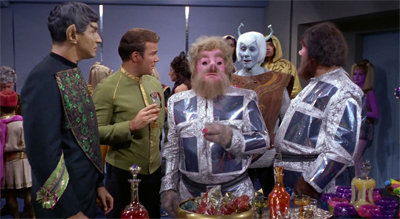
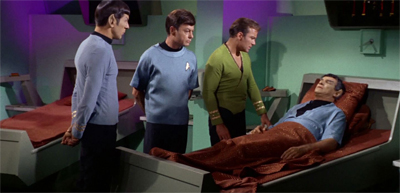






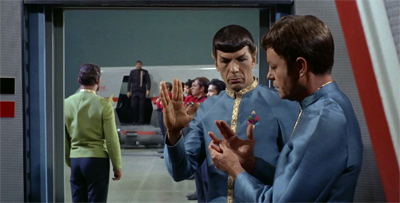











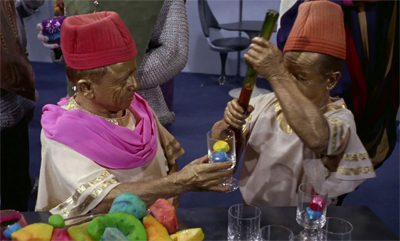
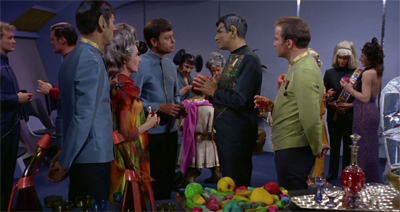


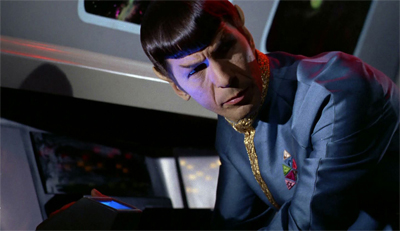






Interesting review! I totally adore this episode, and I’m amazed at what Dorothy Fontana has accomplished here. She packs so MUCH into the episode, yet it doesn’t feel rushed or cluttered or incomprehensible. It’s really an impressive writing job. I wish they had HER writing the reboot movies!
This is my second-favorite TOS episode (after “Amok Time”), and I think it’s brilliant on so many levels. The scene in Spock’s quarters, where Amanda slaps him — god, Spock’s courage gets me every time. Regardless of whether one thinks he’s making the right decision there, one has to appreciate that this decision is COSTING him, big time, but he will do what he thinks is the right thing, regardless of how much it breaks his heart, because that’s who Spock is. He’s a man and a half, and that scene simultaneously breaks my heart and gives me so much respect for Spock.
But even though it’s a Spock-centric episode, Kirk still has a chance to shine. Getting out of bed with a knife wound and pretending he’s fine so that Spock’s doing his duty DOESN’T cost him both his father’s life and his mother’s love, that’s a wonderful testament to Kirk’s character. And then his ability to fake out the Orion captain while on the verge of passing out from a knife wound — that’s our Kirk, all right.
Can you imagine how surprised Mark Lenard must have been to get a call to be in “The Search for Spock” SEVENTEEN YEARS after he did a one-week guest star stint in a TV show that had been cancelled fifteen years before? 🙂
I’ve always seen the actress who played Amanda listed as JANE Wyatt, but you have her as Jean. Is this a typo on your part, or did she prefer to be called “Jean”?
Oh, and I love your pointing out the metaphor behind there being something wrong with Sarek’s heart and the way that Spock has been “filtering out the human factors” all of his life. That’s a great point, and one I haven’t seen anyone else make. As always, you add depth to episodes I think I’ve already thought about as much as is humanly possible, only to have you show me a new way to think about them. 😉
Thanks for the kind words! As you point out, there’s been an awful lot written about these episodes, so there’s really very little I can add – except to meticulously source and research them. That said, I’m kinda looking forward to doing Enterprise and The Animated Series, because those are relatively under-explored pieces of the Star Trek canon.
Good spot, it’s Jane Wyatt! I suspect I typoed the first time and just went with it, like turning into a skid. That’s what you’re meant to do, right? 🙂
Very interesting review.
I know I’ve harped on about Spock loudly burying his human side as creepy and problematic (because it IS creepy and problematic and a huge stumbling block for me liking that character given how lionised he is) but I do find the Spock family dynamic intriguing.
Also Andorians! I will forgive ‘Enterprise’ (the show) almost everything for delving into this species.
Andorians are freakin’ awesome. It’s a shame that (I believe) Rick Berman banned them from the twenty-fourth century shows, because that design is just beautiful and should be one of the iconic Star Trek designs imprinted on the collective consciousness, as opposed to simply a fan favourite. (Much like everybody knows what a Klingon or a Vulcan looks like.)
Great post. I used to be checking continuously this weblog and I
am inspired! Extremely helpful information specially the ultimate section 🙂 I handle
such information much. I was looking for this certain information for a very long time.
Thanks and good luck.
Just saw this episode, def. now among my favorite episodes in the entire franchise, and interesting to see the backstory (or forestory I guess) of the Babel three parter in Enterprise. Though it’d have been nice to visit Babel here or in that three parter.
I like Babel being a place we’re always traveling towards, but never arriving at.
But Journey to Babel is a stone cold classic. Leonard Nimoy and Mark Leonard are phenomenal in it.
Yeah it’s an excellent episode all around, love how it basically cemented the Federation into Star Trek